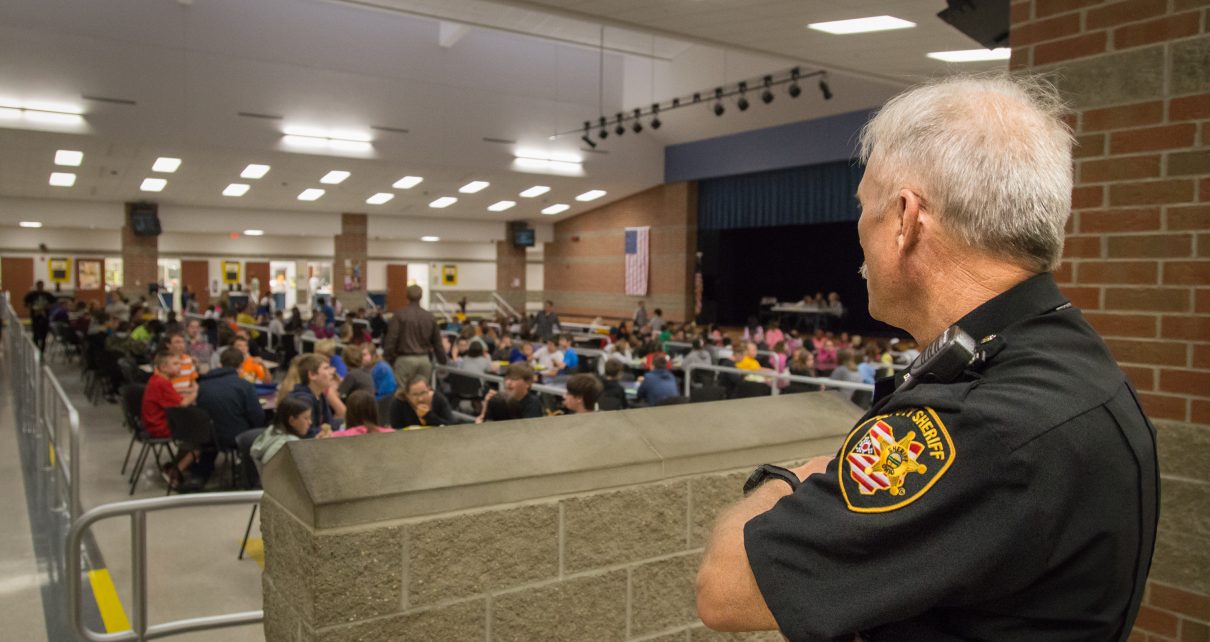
A school security guard watches over a school cafeteria (Photo: Shutterstock)
Creating Safe Schools: You’re doing it wrong
OPINION: Safe schools are achieved by ‘Doing ordinary things, extraordinarily well’
By Paul White, June 8, 2022 9:35 am
I waited to write this until the post-Uvalde tidal wave of “How to make schools safer” articles came out. I hoped that at least someone might get it right. They didn’t. Nothing I’ve seen has come close to offering the only solution there is for preventing school violence. There’s a good reason for that.
None of the articles that spoke with such authority about how to make schools safe—not a single one—was written by a school administrator or teacher who’s actually accomplished that feat…repeatedly.
Over many years, I’ve had personal, full responsibility for making over a dozen schools and countless classrooms as safe and peaceful as your living room. This was accomplished largely with extremely challenging clientele. As an added plus, those students in my schools were typically years below grade level when they enrolled, but were academically advanced and usually clean-and-sober by the time they left. (Side note: these two items are inseparably connected to creating safe schools, but did you see either one mentioned in the countless post-Uvalde articles?)
How do you create safe schools that prevent violence? The typical ideas proposed after the Texas tragedy included some or all of the following suggestions:
• Armed school police officers and security guards
• Most student discipline being maintained not by teachers and administrators, but by police-style guards.
• In-school social workers and/or mental health workers
• Metal detectors
• Arming all school staff
• Classroom “panic buttons” and/or Safe Rooms
• Indoor security cameras
• Bullet-proof glass, fewer/smaller windows, and special security doors
• Not allowing unscheduled drop-in campus/classroom visits by anyone.
If you’re serious about having non-violent schools, you do not want to implement ANY of the items on that list.
Unintentionally, they create a harsh culture of fear, animosity, distrust, and social dis-ease that actually incubates the very problems schools seek to prevent.
If the best way to prevent violent incidents was via armies of weaponized guards, heavily locked down impersonal facilities that allow no outside visits, omnipresent cameras, constant checking of students for lethal contraband, and ignoring issues like raging drug abuse, then prisons would be the safest places in the nation. But they’re not. The most restrictive prisons typically have the most violence and mental health issues. In proportion as schools pursue this path, they reap the same results.
Creating safe schools is achieved by following a well-known definition of excellence: “Doing ordinary things, extraordinarily well.“ The following are just a few of the proven procedures I’ve implemented effectively with thousands of students, that prevent violent behavior.
• Absence and Tardiness – Safe schools demand from parents – without exception, a 90+% daily student attendance and punctuality rate, instead of the increasingly common 50-70%. There are many reasons why students miss excessive amounts of school and/or are chronically late to class. None of them are good. All of the reasons, undealt with, lead to bigger school problems later on and undermine any attempt to provide students a quality education.
• Entering and Leaving the Building – Safe schools have one entrance and one exit for students. They always have two or more teachers/administrators providing an unhurried, thorough “welcoming” to every student, every morning. Engaging in conversation and careful observation of all arriving students – every day (appropriate dress and behavior? under the influence? emotionally disturbed? etc.) – helps weed-out more potential problems than body searches and metal-detecting ever could. This method has kept Israel’s El Al airlines one of the safest in the world for decades.
• Student behavior in class and on school grounds – Safe schools enforce all school behavioral rules when the violations are smaller and first appear. Teachers/administrators who don’t deal with a piece of paper being thrown across the room and/or minor disrespect, soon have to deal with flying books or furniture and seriously assaultive behavior. Teachers and administrators who take action at the first onset of unacceptable behavior, build the respect of students and maintain control over their campuses. Teachers and administrators who refuse to personally challenge student misbehavior, and then call for security or school police when the behavior becomes out of control, undermine their own authority, lose all student respect and their schools fall apart.
• Voluntary drug-testing – The best and safest schools get most of their students to voluntarily drug test. Implemented properly, there’s no better way to build a school culture of pride, respect, and safety. When an acceptance and desire for voluntary drug-testing takes hold among students, and when a campus begins to experience the numerous benefits of a clean/sober student body, kids start to intrinsically want to do the right thing. They begin to hold each other accountable for their behavior, and students who opt out of drug-testing, almost without exception, self-identify as needing close scrutiny.
• Loving your students – You don’t hear anyone talk about this most critical component for creating safe schools. It’s because too many educators stopped genuinely caring for their students a long time ago. Non-school-related security experts would say that loving your students has nothing to do with the school safety conversation…but they’d be dangerously wrong.
The truism that “Hurt people hurt people” must be understood before safe schools can become the rule, rather than the exception. School communities where all staff and students care enough to identify these tormented and easily identifiable individuals, and lovingly confront them until they are no longer in pain, is the key to preventing future Uvalde’s, Parkland’s, Sandy Hook’s, and Columbine’s. Combining this powerful expression of compassion – and wisdom – with consistent, reasonable discipline and unexcepted supervision of all students all the time, is the only way to create and maintain safe, effective schools. I know this is true. I’ve repeatedly done it.
Paul D. White is currently serving as a consultant to the Joey Gilbert for Governor campaign.
- OPINION: Washoe County Schools: NOTFixable… - June 23, 2025
- OPINION: “Murder” and Washoe County’s CARES Campus. Who’s Responsible? - June 17, 2025
- OPINION: June 14 Rally Organizers: “We Need Mindless Protesters.” - June 11, 2025





Sports and concert venues, theaters, junk yards, flea markets etc allow people in and out under controlled circumstances. Haven’t seen many shootings at football, baseball or basketball games…. Nothing is perfect but as the author points out – some simple protocols work.